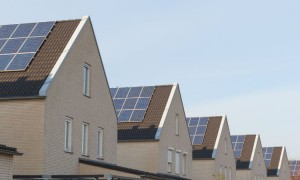Guest post by Lauren White
The solar panel industry has developed exponentially, in the past decade. Much of that is owed to increased demand. According to the Department of Energy, Americans use 23 times more solar energy now than we did around ten years ago.
Homeowners have more solar energy options than ever before. In order to meet demand and outshine the competition, companies are putting their resources toward research and development. They are constantly working toward creating more efficient and innovative solar energy technology.
Once you have decided to install solar panels, it’s important to research which solar panels are best for you, your home and your budget. There are generally three solar panel choices for residential homes: Thin-Film, Polycrystalline and Monocrystalline. These three panels are part of solar photovoltaic (PV) systems, which means they convert the sun’s photons into electricity.
Thin-Film
Perfect for: The homeowner with a small budget, a low-to-average rate of energy consumption, and lots of area for installation.
The cells of thin-film panels are constructed by layering photovoltaic material on glass, metal or plastic. These layers can be measured in nanometers, significantly thinner than in traditional panels. Their thin construction makes them lightweight and flexible, and they have a low cost of production. As such, they come at a lower cost to consumers.
One drawback of this technology is its rate of degradation. These solar panels have an average life expectancy of 10-15 years, depending on the photovoltaic material used. Comparatively, monocrystalline solar panels have a life expectancy of 25-35 years.
Another drawback is their low efficiency rating of 7-15%. This rate doesn’t work well for homes consuming more than the national average of 11,000 kWh per year. Also, these panels must be installed over a significant amount of space, which can be a deterrent for homeowners with limited area for installation.
In recent years, technology has improved and certain thin-film technologies are pushing past 20% efficiency. With a higher efficiency rating, this technology can meet higher energy demands and become a greater competitor in the market.
Polycrystalline
Perfect for: The eco-conscious homeowner with wiggle room in their budget, an average rate of energy consumption, and perhaps a penchant for the color blue.
Polycrystalline panels are constructed by melting silicon into molds to create perfect square “wafers.’ These wafers of silicon are then installed on a grid to form the panel. The cost of making these panels is relatively low and the process produces minimal waste. This makes polycrystalline a more affordable option than the original solar panel, monocrystalline.
The efficiency rating for polycrystalline panels is typically 13-16%. They would perform best in homes with typical rates of consumption. You will still need a significant amount of installation space, for these panels, in order to achieve optimal benefits. You must also take into consideration whether or not your taste will agree with their blue tint.
Monocrystalline
Perfect for: The homeowner with less roof space for installation and/or a higher rate of energy consumption, who wants a longer-lasting product and can make a sizeable investment.
Monocrystalline panels were the first solar panels to be made available. Currently, they are some of the most expensive. Each panel is created using high-purity silicon cut into “wafers.” These silicon wafers are extremely efficient at converting photons into energy, with monocrystalline panels hovering around a 22% efficiency rating.
Since these panels can convert more energy per square foot, you won’t need as much space for installation. Greater energy conversion also means you’ll be able to power more appliances, like hot tubs, heated pools and electric cars.
Get What You Pay for—and Then Some
In most cases, homeowners surveyed by HomeAdvisor say the cost of installing solar panels is much less than their projected energy savings over a twenty year period. In fact, it’s been estimated that, in 2017, homeowners in Massachusetts and California will save double their investment in solar energy.
Calculate Your Estimated Savings
If you’re not sure of your ROI, Google has a convenient tool called Project Sunroof, which will calculate your estimated savings based on your specific home address. As for your installation cost, you can request local estimates through HomeAdvisor to get a realistic figure for budgeting.
While you’re doing your research, or when you are speaking with a professional, see what’s new and on the horizon in the industry. These technologies are developing so rapidly, there are breakthroughs on a yearly basis. In July of 2017, for example, scientists developed a solar cell with 44.5% efficiency. There is hope that this technology, and others like it, can be streamlined and integrated into the residential and commercial solar market.
Lauren White is a freelance writer who enjoys reading, hiking and traveling. She can usually be found on an outdoor adventure with her boyfriend and little sister on the weekends.






